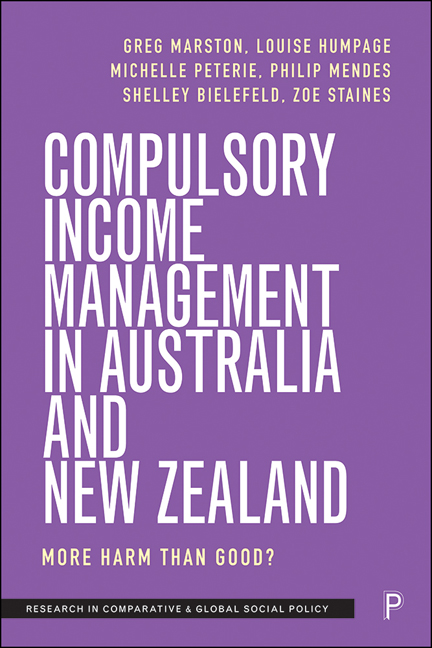Book contents
- Frontmatter
- Contents
- List of abbreviations
- About the authors
- Acknowledgements
- Series preface
- 1 Framing welfare conditionality
- 2 Why Income Management?
- 3 Barriers to implementing Compulsory Income Management
- 4 Identity and emotion
- 5 Procedural, consumer and contractual rights, and access to justice
- 6 Resistance and reform: individual and collective agency
- 7 Voluntary Income Management and financial education
- 8 Recalibrating social security and reimagining work
- References
- Index
2 - Why Income Management?
Published online by Cambridge University Press: 08 October 2022
- Frontmatter
- Contents
- List of abbreviations
- About the authors
- Acknowledgements
- Series preface
- 1 Framing welfare conditionality
- 2 Why Income Management?
- 3 Barriers to implementing Compulsory Income Management
- 4 Identity and emotion
- 5 Procedural, consumer and contractual rights, and access to justice
- 6 Resistance and reform: individual and collective agency
- 7 Voluntary Income Management and financial education
- 8 Recalibrating social security and reimagining work
- References
- Index
Summary
Introduction
This chapter explains how the Australian and New Zealand governments both arrived at a moment where IM was considered a viable policy idea, then implemented and extended it over time. Drawing on parliamentary debates, policy documents and interviews with politicians and policymakers, the policy process in both countries is traced, drawing particular attention to the political discourses used to frame IM. This reveals what political ‘problem’ each government identified. In Australia, where discourse was highly racialised, existing tropes around the need to ‘save the children’ and reduce ‘criminality’ within Indigenous communities were dominant. In New Zealand, a broader welfare conditionality discourse aimed to ‘save’ the young people subject to CIM, largely from their parents but sometimes from the state; but this was less explicitly racialised, even though Indigenous peoples – along with sole parents and disabled persons – are disproportionately more likely to receive social security payments and thus be under IM administration. Distorted representations of community crime and crime reduction were also not a prominent feature of the policy justification for IM, as in Australia. To explain these differences, the chapter indicates how international trends in welfare conditionality intersected with and were mediated by existing political discourses, interests and institutions to embed CIM policy into both countries’ social security systems.
Analysing Income Management within the broader policy field
As Chapter 1 highlighted, IM emerged from an international context in which forms of welfare conditionality are increasingly framed as not only appropriate but necessary to address the ‘welfare dependency’ associated with social security recipients. The ideational dimension of policy change and social problem framing is always political because to evoke the origin of a social problem is to assign blame and praise (Edelman, 1988; Bacchi, 2009). ‘Welfare dependency’ situates dependency on the state for income support as negative and corrosive (Fraser and Gordon, 1994; Jensen, 2014) while other forms, such as dependency on markets, are regarded as natural and virtuous. The valorisation of a (paid) ‘work ethic’ as the solution in Anglophone countries thus both narrows understandings of welfare to a form of cash transfers and suggests solutions located in both market participation and individualism.
- Type
- Chapter
- Information
- Compulsory Income Management in Australia and New ZealandMore Harm than Good?, pp. 20 - 45Publisher: Bristol University PressPrint publication year: 2022

